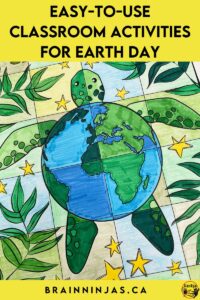
Every day in our classroom is Earth Day. It’s part of our science lessons to learn about energy conservation, so it’s easy to make sure we talk about the importance of conservation regularly.
One year a fellow teacher thought it would be a great idea to print a little paper globe for each student in our school (that’s several hundred) and write a “thank you to the Earth” type sentence.
I don’t often speak up at meetings, but I couldn’t resist this one. Isn’t it counterproductive to teach students about conservation by wasting all that paper?
Everyone agreed, but NO ONE had any suggestions on what we could do instead. And that’s how we came up with this list of Earth Day activities (and why you should try some of them).
Outside Activities for Earth Day
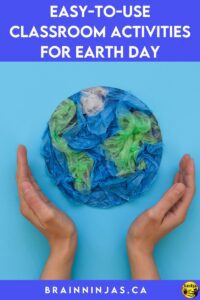
Do a Litter Chase
Pick up garbage in your schoolyard. We had a teacher who had all her students wear plastic gloves to do this. While we understand that garbage is dirty, plastic gloves are not helping with the problem. Have students wear one glove or no gloves and then show them how to wash their hands.
Plant Something
Check with local greenhouses for bedding plants or buy some seeds. Our students care for the school’s flower garden. If you don’t have access to a garden, plant little plants in paper cups that your students can take home and plant.
If you have a place to plant wildflowers for bees or butterflies, you’ll help these creatures survive in your area.
The Birds and Bees
If your school has birdhouses or bee homes, teach your students how to care for them. Clean out bee houses and birdhouses with mild soap and water. You should also clean out feeders. Without regular cleaning, these can make the very creatures you’re hoping to help sick.
Go for a Walk
Talk a short walk with your class and point out some of the wonderful things you see.
Explore
Take magnifying glasses outside and look at the spring buds up close. Talk about the changes of the plants and flowers. Touch the leaves and the grass, but talk to your students about leaving nature where it belongs.
Build the Perfect World
Using sand or snow have your students create a world they would consider perfect. What qualities does it have?
Read our post How to Grow a Healthy Classroom for more ways to get your class out into nature. If your students are interested in learning more about environmental stewardship, check out Foster Environmental Stewardship in the Classroom.
Inside Activities for Earth Day
Hour of Energy
Turn off the lights and as many electrical devices as possible for an hour. Turn this into a math lesson by counting light bulbs, kilowatts or kilo joules of energy this saves.
Make Recycled Paper Art

Take some of your already used paper. Tear it into tiny pieces. Each student will need a fist full of torn paper. Mix one tablespoon of flour and one tablespoon of water. Mix this with the ripped paper and knead it like dough for several minutes. Shape this into something and let it dry. To make it into paper, roll it flat.
Create a Piece of Art
We created a resource full of lessons that use recycled materials. Our favourite is the upcycled robots. You can find the Upcycled Art Projects resource in our TpT Store ($USD) or our BN Shop ($CAN).
You can get our sample upcycled art lesson in our Resource Library. We can send you a copy when you join our ninja news email list.
Create a collaborative poster. This works by each student colouring a piece (and sometimes a few pieces). The pieces are assembled into one poster. Our Earth Day Collaborative Poster is one of our favourite creations of all time and we get so many comments about it on our bulletin board. The poster resource comes with 18, 24 or 36 pieces so you can use it with any size class. It also includes a follow-up activity. Find the Earth Day Collaborative Poster in our TpT Store ($USD) and our BN Shop ($CAN).
Upcycle Something
Turn an old food container into storage for school or art supplies.
Garbage Free Lunch
If your students bring a lunch to school, can they create a lunch that doesn’t leave any waste at school? We put the compostable materials in our compost bin, recyclables and containers return home.
Make a Pledge For a Daily Change
Ask your students to pick one thing they will do every day to reduce waste. If you must write it down, make it digital or use a previously loved piece of paper.
Learn About Ways to Care for the Environment
Teach students ways to care for the environment and reduce waste. We talk about recycling as a last resort for something. Upcycling and reducing are the best way to reduce waste. We also talk about conserving clean water, preventing pollution and being a responsible global citizen.
Do Some Reading or Writing Activities about Earth Day
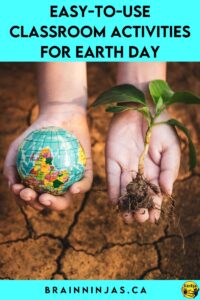
We created some Earth Day Logic Puzzles for this which can be found in our TpT Store ($USD) and our BN Shop ($CAN). Save paper when you use the digital version.
Get your students writing every day with our Earth Day Writing Prompts. You can find the prompts in our TpT Store ($USD) or our BN Shop ($CAN). For more writing ideas, read Challenge Your Students to Write Every Day.
Simple Classroom Changes to Reduce Waste
Since conservation is part of our science curriculum, it’s easy for us to tell students that “not being wasteful in our classroom” is being graded.
Students create a waste reduction plan near the beginning of the school year that we use all year long. We connect this with our science class. Found the Waste Reduction Project in our TpT Store ($USD) or our BN Shop ($CAN).
Paper Products
We communicate with parents digitally (email, school website and Google Classroom are the tools we use) instead of paper newsletters. If parents don’t have internet access, we provide a paper copy to the family.
We use both sides of every single piece of paper and we try to write on the whole page from top to bottom. We even have challenges to see how few pieces of paper we can use in a week or month.
When we need scrap paper we go to the recycling bin and see what we can use from there. Keep all the scraps for future art projects.
We host a book swap. Students bring books for our trading bookshelf and take another one home (our personal special books are not included in this). They can trade these books with each other.
As teachers, we print as few things as possible. Whenever possible we show one copy on the projector instead of printing a copy for every student. If students need their copy to refer to, we scan a copy into their Google Classroom. It’s amazing how many copies you can save this way.
We designed our Reading Passage and Comprehension sets to work digitally so they don’t need to be printed. You can check out the whole set in our store.
Wandering Waste on TpT ($USD) or our BN Shop ($CAN)
Whale Poop on TpT ($USD) or our BN Shop ($CAN)
Plastic Film on TpT ($USD) or our BN Shop ($CAN)
Pacific Garbage Patch on TpT ($USD) or our BN Shop ($CAN)
Waste Innovation on TpT ($USD) or our BN Shop ($CAN)
Food and Water
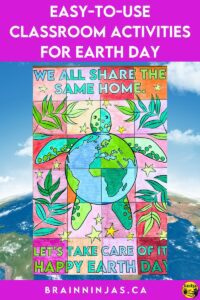
Encourage students to avoid bringing snacks with lots of packaging (prepackaged foods) and instead bring things that can be composted (like a banana peel).
Keep a big bucket with a sealable lid in the classroom for organic scraps. Once a week, we walk this over to the compost pile and wash out our bucket.
We use reusable water bottles instead of plastic bottles. Students are permitted to keep these with them in class (except when using Chromebooks).
Single-use forks, spoons, knives and straws are not allowed in our school. Each classroom has a set of dishes that can be used, washed and reused by students. Students are encouraged to bring utensils from home (we don’t have a cafeteria so students bring a brown bag lunch every day or go home for lunch).
When we host events, we ask parents not to bring or buy food products with too much packaging. They can buy bulk items or make items at home. We try to reduce our party leftovers and garbage.
Other Items
Makerspace
Students bring games and puzzles with missing pieces to be used in our school makerspace. Sometimes we’ve even made a new game by finding spare parts.
Students bring craft materials they aren’t using for others to use.
Students are encouraged to look after their school supplies so they are not wasted.
Bags
Reusable bags only. Students are encouraged to use bags that can be used over and over again instead of any plastic bags. We do use Ziploc bags for some things in our classroom, but these are used all year and sometimes year after year.
Transportation
Walk (skateboard, scooter or ride a bike) to school as often as possible. We are fortunate that our students do not take buses to arrive at school and their parents usually walk with them instead of driving and dropping them off. The teachers carpool together (partly because there is no parking). We forgive this when the weather is colder than -20 degrees Celsius.
Math
And if you want to celebrate Earth Day, but still need to do math lessons, you can use our worksheets.
Grade 3 Earth Day Math Worksheets are in our TpT Store ($USD) or our BN Shop ($CAN).
Earth Day Math Worksheets for Grade 4 can be found in our TpT Store ($USD) or BN Shop ($CAN).
Grade 5 Earth Day Math Worksheets are in our TpT Store ($USD) and BN Shop ($CAN).
Great Books to Read for Earth Day
We regularly talk about reading to our upper elementary students. They love being read to and often we forget that this age still needs to be read to. Share a book with them today.
Picture Books
- Here We Are by Oliver Jeffers This is a wonderful story outlining what someone would need to know about Earth from the time they are a baby.
- Here Comes the Garbage Barge by Jonah Winter This is the mostly true story of how one city put all their trash on a barge and sent it out to the ocean-a waste management plan with destructive consequences.
- The Great Kapok Tree A Tale of the Amazon Rain Forest by Lynne Cherry This book explains the importance of trees to our environment and overall health.
- One World by Michael Foreman This is a close-up of how pollution impacts our world through the eyes of a boy at the beach.
- City Green by DyAnne DiSalvo-Ryan A girl creates a community garden in her city.
- Lonely Polar Bear by Khoa Le This is a book explaining climate change in its simplest ways for younger children.
- George Saves the World by Joe Readman and Lee Honor Roberts George is challenged by his grandfather to recycle and it changes his views about the world.
More Picture Books
- Compost Zoo by Mary McKenna Siddals This is an alphabet book that explains composting.
- Touch the Earth by Julian Lennon This is the beginning of a trilogy where you can take a plane anywhere to help make the world a better place.
- Kate, Who Tamed the Wind by Liz Garton Scanlon & Lee White Kate finds a way to solve her problem in an environmentally friendly way.
- Green by Laura Vaccaro Seeger This is a way to see all the signs of green in nature.
- One Plastic Bag: Isatou Ceesay and the Recycling Women of the Gambia by Miranda Paul A group of women use plastic bags to start a business while cleaning up their community in the process.
- The Last Plastic Straw: A Plastic Problem and Finding Ways to Fix It by Dee Romito This is a great history of the straw and how it has become a threat to our planet.
- The Mess That We Made by Michelle Lord This explores the damage that trash does to us all.
Craft, Activism, and Idea Books
- Greta and the Giants: Inspired by Greta Thunberg’s Stand to Save the World by Zoë Tucker This is the story of a girl who lives in the forest being chopped down by giants. She stands up against the giants. This one is inspired by the activism of Greta Thunberg.
- 10 Things I Can Do to Help My World by Melanie Walsh This one is great for adults too, explaining ten simple things we can do to help reduce our impact on the environment.
- Kenya’s Art by Linda Trice This is a book showing different ways recycled materials can be turned into art projects.
- Follow the Moon Home by Philippe Cousteau This is the story of a group of young people who learn that working together can make a difference to the world.
- All That Trash by Meghan McCarthy This is another story about a garbage barge that started a recycling movement.
- Miss Maple’s Seeds by Eliza Wheeler This is a story about taking seeds and nurturing them into plants.
Non-Fiction Reads
- Bee & Me by Allison Jay This adorable book helps younger environmentalists understand the importance of bees in our ecosystem and food chain.
- The Water Princess by Susan Verde We take our running water for granted in many places. This is the story of a young girl’s journey to bring water to her village.
- One Plastic Bag by Miranda Paul This book is beautifully illustrated and explains the challenges faced in one community and how they solved it in a creative way.
- Seeds of Change by Jen Cullerton Johnson This book talks about the life of Wangarĩ Maathai, one of Kenya’s most famous environmentalists.
- Momentus: Small Acts of Change by Hannah Alper This is a how-to guide to activism by sharing interviews with other activists, celebrities and change-makers.
- Don’t Let Them Disappear by Chelsea Clinton This book highlights twelve endangered animals and explains ways to help prevent their extinction.
- Earth Ninja: A Children’s Book About Recycling, Reducing, and Reusing by Mary Ninh This book explores our impact on the Earth.
- The Watcher by Jeanette Winter This is a biography of Jane Goodall, who studied gorillas.
Other booklists
- Books for Remembrance Day
- Kindness Books
- Books for Ramadan
- Christmas Books We Love
- Cozy Up With Great Winter Books
- Books for Lunar New Year
- Orange Shirt Day (Residential Schools and National Truth and Reconciliation Day)
- Holi Festival of Colours
- Books With Great LGTBQ+ Characters
- Black History Month
- Asian Heritage Month
- Thanksgiving
- Books for and About Powerful Women
- Books by Indigenous Authors
And we have books for teaching all year round:
Kindness Books
Poetry Books
Social Emotional Learning
We’ve noticed over the past few years that students are genuinely concerned with the lack of action by governments around the world to help protect the environment. Encourage your students to take action where they live. If everyone does their part, we can take care of the planet together.
Do you have a great activity for Earth Day? Share it with us in the comments below.

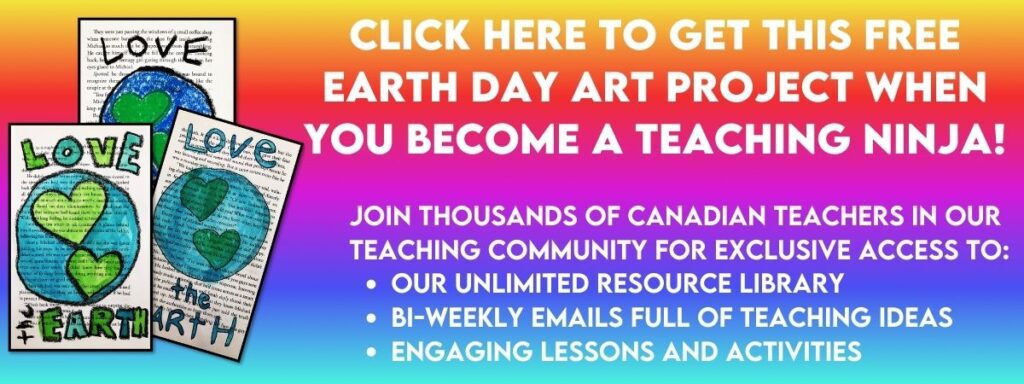






you guys are awesome!!!! honestly thee best
you guys are awesome!!!!